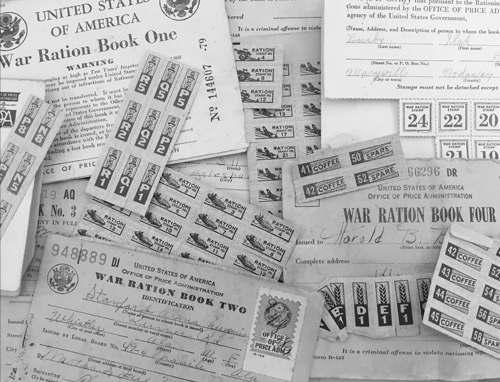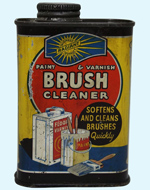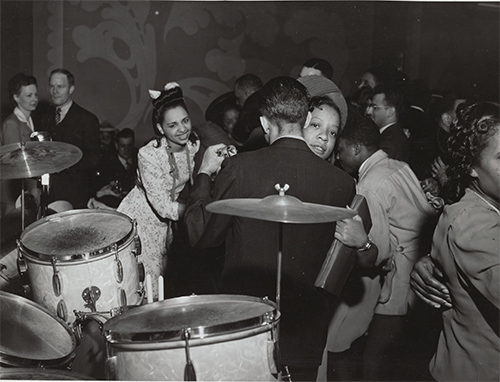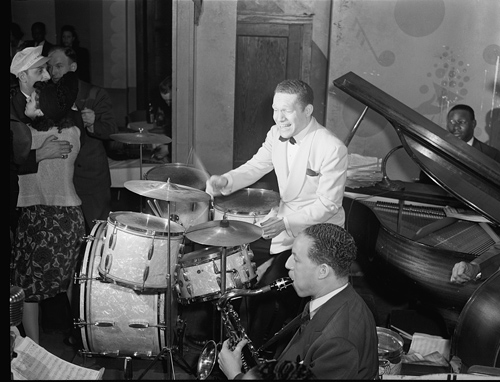Part 1 | 2 | 3 | 4 | 5 | 6 | 7 | 8 | 9 | 10 | 11 | 12 | 13 | 14 | 15 | 16 | 17 | 18 | 19 | 20 | 21 | 22 | 23 | 24 | 25
During the 1990s, a few years before my father, Dave, passed away in December of 2000, he wrote a 35-page autobiography. Excerpts from it will be published here, as companions to the diaries my mother, Dorothy, kept in 1945 and 1946—the year she met Dave. My dad was born in 1927, in Hamilton, Ohio. The family eventually moved to the south side of Chicago.
Part 10
The Homefront
There was excitement in the air during the weeks after Pearl Harbor and President Roosevelt's declaration of war. The newspapers were full of stories and pictures of the long lines at recruiting centers and the flags in the windows of every house. Men in uniform began appearing everywhere around town. Many businesses hung signs in the doors that read “Servicemen Free.” Restaurants offered them half-price meals, movie theaters offered free admission and Chicago's streetcars, free rides. The whole city seemed to change in an instant.

Wartime ration books, cards, and stamps
At Mrs. Ragio's boarding house, where I was now living, everyone signed up for the new ration cards. The goods in neighborhood shops now displayed the number of ration points required, in addition to their prices. Auto windshields showed stickers indicating the amount of gasoline that could be purchased. Instructions were issued by the government on how to save soap, fats, iron, tin and all the other items needed for the war effort.
There was excitement in the air. The Chicago newspapers told of soldiers and Marines on Wake Island and Corregidor, holding out for a time, and later being captured by the Japanese. In the papers, Japan was depicted as a tide of black ink, each succeeding day covering more and more land area.
We, of course, knew about the fighting in Europe, but it was a secondary experience for us. The war with Japan was what we talked about, and what we heard about.
 During this wartime summer of 1942, my friends Bud and Doty came to work with me at the Midway Chemical Company in the Clearing District [photo of a Midway product at left.] Bud's job was loading trucks, Doty's was in the office. Mine continued to be that of bending wire frames for mops. Our wages were $1.25 per hour, compared to $3.00-$4.00 per hour for skilled, adult factory workers (I was only 15 years old at the time), and, in light of this, it wasn't long before I decided to move on. During this wartime summer of 1942, my friends Bud and Doty came to work with me at the Midway Chemical Company in the Clearing District [photo of a Midway product at left.] Bud's job was loading trucks, Doty's was in the office. Mine continued to be that of bending wire frames for mops. Our wages were $1.25 per hour, compared to $3.00-$4.00 per hour for skilled, adult factory workers (I was only 15 years old at the time), and, in light of this, it wasn't long before I decided to move on.
I'd gotten word of a place called Berg Sales, a store where a person could purchase goods cheaply, and then sell them at a discount after marking them with inflated prices. I proceeded to use all my savings to buy from Berg two dozen sets of kitchen knives with wooden wall racks for $2.50, and a case of white, “Pepperhill” double-size bed sheets for $1.50. During the remainder of the summer, I made a nice living peddling the knife sets for $10 and the sheets for $5 to taverns, restaurants and various other stores.
Capitalizing on my success, I'd return to Berg Sales, leaving with cardboard boxes full of watches, comb-and-mirror vanity sets, tie pins and cuff-links, barely managing to board the streetcar. My dollar tip to the conductor held the streetcar long enough for me to load and unload my inventory.
Eventually, my pal Bud joined my new business venture becoming a partner and employee. I gave Bud goods to sell on open account at double my cost, and then he paid me after he'd sold them. Bud and I did particularly well working the taverns west of Halsted St. on 63rd, but also at other establishments in the general area. At one, the Club DeLisa,† a prohibition-era “colored” club at 55th & State St., the owner allowed me to sell my goods prior to the evening's shows. At that time, and at my young age of 15, it was fantastic to see the lights, makeup tables, rooms full of half-undressed black women, and to take in the many aromas. It was a trip to heaven.

Dancing to the music of Red Saunders at Club DeLisa in 1942. [Wikipedia]
The two or three dozen performers and musicians at the club bought loads of stuff from me. After a while, they became almost my only outlet. I was kidded a lot. “Cute white boy,” and “Come back when you get some size,” were accompanied by pats on the butt. Old-timers, mainly the band members, would tell me stories about the days of prohibition at the club, and about the tunnel they'd use under 55th St., when police would conduct raids. They also told of the “fancy girls,” who serviced customers in the upstairs rooms.
As the story went, the original owner of Club DeLisa had come from New York City's Harlem, opened the club, and threw away the key—the place never closed, operating day and night for many years. Al Capone, who had a home, wife and family at 69th & Prairie Ave., owned the “fancy girls,” and was a regular patron.
To keep all this in perspective, one has to remember that at the time there was no danger in traveling or associating in these “different” sorts of neighborhoods. Despite the inequalities that existed, a white person being together with, and talking to, black people was not something to be feared.

Red Saunders, at Club DeLisa
During the summer, my brother Charlie and I got together occasionally. He had left the Civilian Conservation Corps and was now renting a room at 69th & Morgan. In the early fall, when Charlie was drafted into the Navy, I inherited his brand new Schwinn bicycle. It was perfect timing, as this would be my transportation to and from Tilden High School at 47th & Union, where I'd just enrolled at my older brother Oregon's urging, he being an alumni who'd been the editor of the school's Tilden Times newspaper in his senior year.
But in January of the following year, 1943, I dropped out. It was not that I didn't like high school—I did. The work was not difficult for me. But I'd been hustling for so long that I'd become impatient. I just wanted to get on with things.
I soon would.
* * *
End of Part 10
† Red Saunders was leading the house band at the 1000-seat Club DeLisa during the year 1942. Count Basie, Fletcher Henderson and LaVern Baker were some of the talents who performed at the club during its existence from 1933 to 1958, when it closed. —David
Part 1 | 2 | 3 | 4 | 5 | 6 | 7 | 8 | 9 | 10 | 11 | 12 | 13 | 14 | 15 | 16 | 17 | 18 | 19 | 20 | 21 | 22 | 23 | 24 | 25
|

